#chien c. lee
Explore tagged Tumblr posts
Text

The Spotted-winged fruit bat (Balionycteris maculata) is the smallest fruit bat species in the world. It typically roosts in the crowns of tall palms and epiphytic vegetation, but has also been known to excavate roost cavities in termite nests. Sarawak, Malaysia (Borneo). Photo by Chien C. Lee.
167 notes
·
View notes
Text
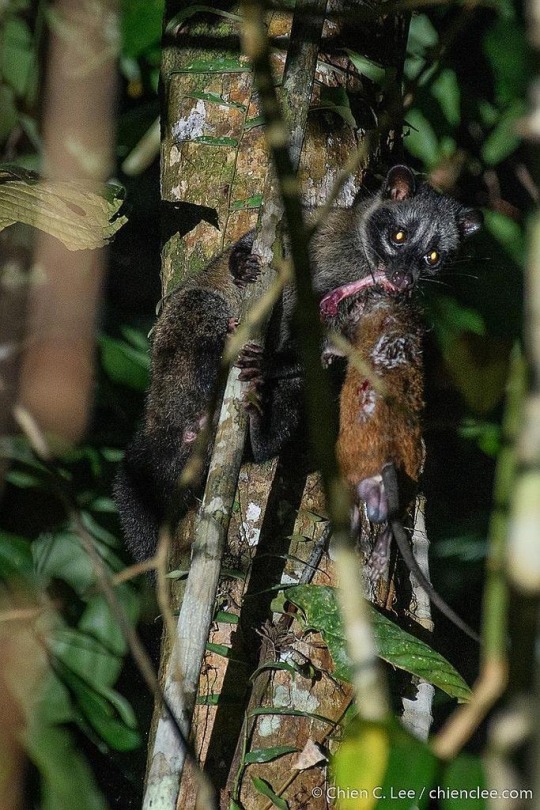
Philippine Palm Civet | Chien C. Lee
#photo#viverridae#paradoxurinae#paradoxurus#paradoxurus philippinensis#philippine palm civet#carcass#chien c lee
10 notes
·
View notes
Text
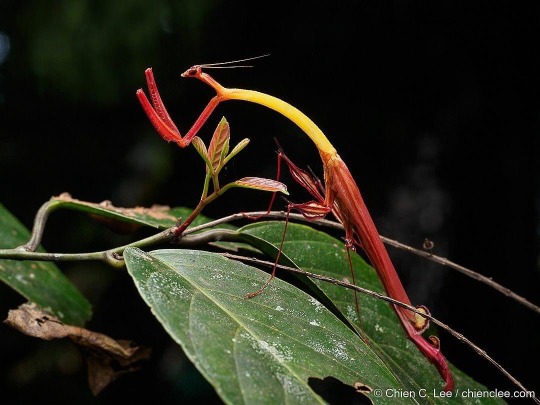
Red-and-yellow Slender Flower Mantis (Toxodera integrifolia), female, family Toxoderidae, Malaysia
Photograph by Chien C Lee
4K notes
·
View notes
Text

A fried eggs worm (Archipheretima middletoni) in Aurora, the Philippines
by Chien C. Lee
#fried eggs worm#earthworms#annelids#archipheretima middletoni#archipheretima#Megascolecidae#Opisthopora#Clitellata#Annelida#wildlife: philippines#wildlife: asia
839 notes
·
View notes
Text

Silky Anteater aka Pygmy Anteater (Cyclopes dorsalis), family Cyclopedidae, order Pilosa, NW Ecuador
photograph by Chien C. Lee
428 notes
·
View notes
Text
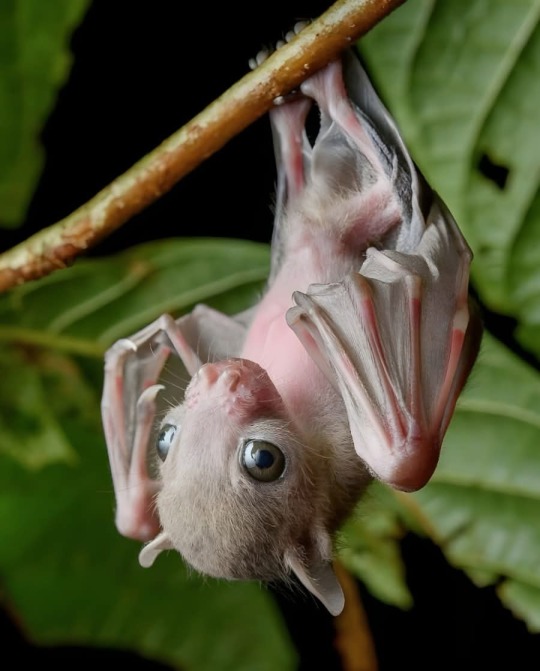
"... baby bat, with its wide eyes and delicate wings, showcases the softer side of these often misunderstood creatures.
Bats are essential pollinators and pest controllers, and this little one is no exception, starting its journey to becoming a vital part of nature's balance.
✨ Fun Fact: Some bat species can eat up to 1,200 mosquitoes in an hour!"
📸: Chien C. Lee
credit: 1 Minute Animals
290 notes
·
View notes
Text

Hardwicke's Woolly Bat, photographed by Chien C. Lee, (source)
#Hardwicke's Woolly Bat#kerivoula hardwickii#bat#bats#cute bats#daily bats#bats of asia#batposting#chiroptera#microbat#microchiroptera#woolly bat#kerivoula#vesper bat#vespertilionidae#yangochiroptera
201 notes
·
View notes
Text



Bark spiders (Caerostris spp.) by Chien C Lee on Flickr, originals at flic.kr/p/2kHkm3J & flic.kr/p/2qqA9zG & flic.kr/p/2kJQyGW. (Posting images directly here so I can add alt text.)
This week I was distraught - genuinely fkn mortified - to discover that my lovely other half, my beloved Kitty the cat-human, doesn't... I mean truly *does not*... Think that bark spiders are friggin adorable.
I weep, OMFGs.
Like. I know I should just be happy that they've come to a point where they evict spiders with a cup & card, instead of squishing them.
But bark spiders.
I mean.
Bark spiders are so cool! They look like bark, FFS.
Look at these bark spiders. Behold them! These fancy spood ladies. The twiggy lookin butts. Their smol faces. Glorious weirdos, how could you be mean to a tiny mush like that? The females only get to a couple of centimetres apparently, males are much smaller. They're soo smol, it's not like they're gonna hurt you Kitty? I mean... Look how anxious they look hugging their twigs?? (Gestures at the world) I feel you, little buddies.
I know they're not the most elegant spoods in webs or wombling around, but they are good cryptic critters, pls be nice to them.
#spider#spiders#arachnid#arachnids#bugblr#arachnida#bark spider#orb weaver#bug#bugs#cool bugs#a beautiful friend#entomology#arachnology#cw spiders#cw spider#cw bugs
87 notes
·
View notes
Text
Macrocilix maia: these moths have a wing pattern that deters predators by mimicking a pair of flies gathered around a pile of bird droppings; the moth even emits a pungent odor to enhance the illusion

This species has developed a very unique defense mechanism -- its wings are decorated with elaborate markings that resemble two flies feeding on a pile of bird droppings.
There are many other moths that are known to mimic bird droppings, but the markings of this particular species are far more elaborate than the markings found on the other species, and the scene that it mimics is especially specific; the addition of the "flies" is also a unique touch, as is the odor that the moth emits.
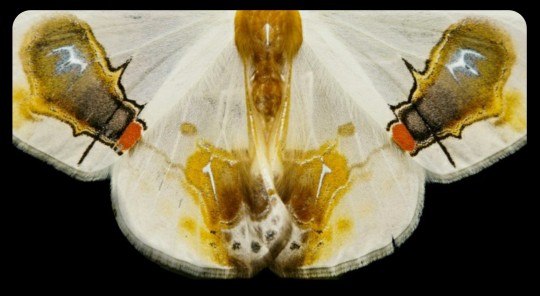
The markings even mimic the sheen of a fly's wings/exoskeleton by including squiggly patches of white at the back of each fly's thorax, and those white patches have a thin, blue outline that gives the flies a blackish-blue appearance (just like actual flies). There are white lines located in the rounded sections of the bird droppings, too, which mimics the glistening, convex appearance of dung.
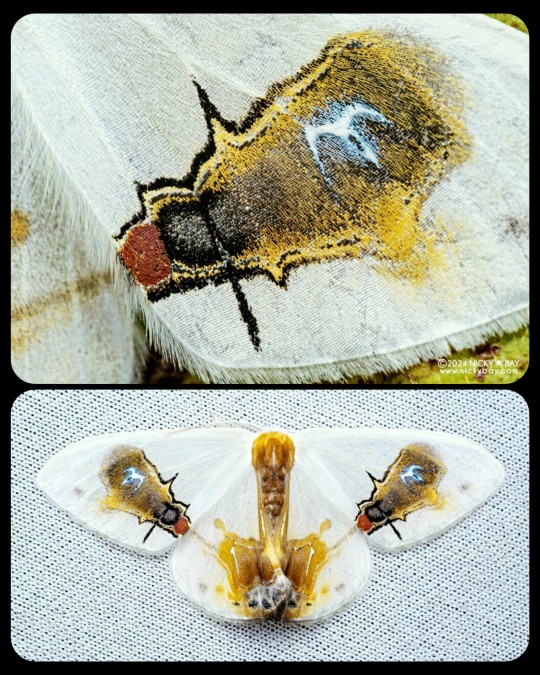
M. maia can be found in the forests/jungles of Borneo, Sumatra, Malaysia, India, Japan, Taiwan, China, and Korea.
Sources & More Info:
Moths of Borneo: M. maia
Moth Identification: Macrocilix maia Moth
Chien C. Lee Wildlife Photography: Fly-Mimic Moth
#lepidoptera#entomology#moths#macrocilix maia#fly-mimic moth#mimicry#animal camouflage#cool bugs#insects#animals#nature#evolution#animal facts#arthropods#weird animals#mimicry among moths#cryptic
247 notes
·
View notes
Text

Northern Silky Anteater, photographed by Chien C. Lee, (source)
#Northern Silky Anteater#cyclopes dorsalis#anteater#anteaters#cute anteaters#daily xenarthras#xenarthras of north america#xenarthras of south america#anteaterposting#xenarthraposting#xenathra#xenarthran#vermilingua#cyclopes#cyclopedidae#pilosa#nature#silly
13 notes
·
View notes
Text

With rainfall sometimes exceeding 4 meters per year, the Borneo rainforest is one of the wettest places on the planet. Waterfalls abound wherever the rugged terrain ends in a steep escarpment. Northern Borneo. Photo by Chien C. Lee.
149 notes
·
View notes
Text
Interesting Papers for Week 15, 2024
Activity-dependent organization of prefrontal hub-networks for associative learning and signal transformation. Agetsuma, M., Sato, I., Tanaka, Y. R., Carrillo-Reid, L., Kasai, A., Noritake, A., … Nagai, T. (2023). Nature Communications, 14, 5996.
Goal-directed recruitment of Pavlovian biases through selective visual attention. Algermissen, J., & den Ouden, H. E. M. (2023). Journal of Experimental Psychology: General, 152(10), 2941–2956.
The mushroom body output encodes behavioral decision during sensory-motor transformation. Arican, C., Schmitt, F. J., Rössler, W., Strube-Bloss, M. F., & Nawrot, M. P. (2023). Current Biology, 33(19), 4217-4224.e4.
Audio-visual integration is more precise in older adults with a high level of long-term physical activity. Azizi, Z., Hirst, R. J., Newell, F. N., Kenny, R. A., & Setti, A. (2023). PLOS ONE, 18(10), e0292373.
Worth the Work? Monkeys Discount Rewards by a Subjective Adapting Effort Cost. Burrell, M., Pastor-Bernier, A., & Schultz, W. (2023). Journal of Neuroscience, 43(40), 6796–6806.
Laminar neural dynamics of auditory evoked responses: Computational modeling of local field potentials in auditory cortex of non-human primates. Chien, V. S. C., Wang, P., Maess, B., Fishman, Y., & Knösche, T. R. (2023). NeuroImage, 281, 120364.
Selective encoding of reward predictions and prediction errors by globus pallidus subpopulations. Farries, M. A., Faust, T. W., Mohebi, A., & Berke, J. D. (2023). Current Biology, 33(19), 4124-4135.e5.
Gate control of sensory neurotransmission in peripheral ganglia by proprioceptive sensory neurons. Fuller, A. M., Luiz, A., Tian, N., Arcangeletti, M., Iseppon, F., Sexton, J. E., … Sikandar, S. (2023). Brain, 146(10), 4033–4039.
Attentional effects on local V1 microcircuits explain selective V1-V4 communication. Katsanevaki, C., Bastos, A. M., Cagnan, H., Bosman, C. A., Friston, K. J., & Fries, P. (2023). NeuroImage, 281, 120375.
Subjective and objective measures of visual awareness converge. Kiefer, M., Frühauf, V., & Kammer, T. (2023). PLOS ONE, 18(10), e0292438.
Immediate neural impact and incomplete compensation after semantic hub disconnection. Kocsis, Z., Jenison, R. L., Taylor, P. N., Calmus, R. M., McMurray, B., Rhone, A. E., … Petkov, C. I. (2023). Nature Communications, 14, 6264.
Atypical cognitive training-induced learning and brain plasticity and their relation to insistence on sameness in children with autism. Liu, J., Chang, H., Abrams, D. A., Kang, J. B., Chen, L., Rosenberg-Lee, M., & Menon, V. (2023). eLife, 12, e86035.
Rapid, Activity-Dependent Intrinsic Plasticity in the Developing Zebra Finch Auditory Cortex. Lu, Y., Sciaccotta, F., Kiely, L., Bellanger, B., Erisir, A., & Meliza, C. D. (2023). Journal of Neuroscience, 43(41), 6872–6883.
Ketamine evoked disruption of entorhinal and hippocampal spatial maps. Masuda, F. K., Aery Jones, E. A., Sun, Y., & Giocomo, L. M. (2023). Nature Communications, 14, 6285.
Orbitofrontal cortex conveys stimulus and task information to the auditory cortex. Mittelstadt, J. K., & Kanold, P. O. (2023). Current Biology, 33(19), 4160-4173.e4.
Prediction error in models of adaptive behavior. Navarro, V. M., Dwyer, D. M., & Honey, R. C. (2023). Current Biology, 33(19), 4238-4243.e3.
Thalamic regulation of ocular dominance plasticity in adult visual cortex. Qin, Y., Ahmadlou, M., Suhai, S., Neering, P., de Kraker, L., Heimel, J. A., & Levelt, C. N. (2023). eLife, 12, e88124.3.
A unified explanation of variability and bias in human probability judgments: How computational noise explains the mean–variance signature. Sundh, J., Zhu, J.-Q., Chater, N., & Sanborn, A. (2023). Journal of Experimental Psychology: General, 152(10), 2842–2860.
Grid cells in rats deprived of geometric experience during development. Ulsaker-Janke, I., Waaga, T., Waaga, T., Moser, E. I., & Moser, M.-B. (2023). Proceedings of the National Academy of Sciences, 120(41), e2310820120.
A theory of hippocampal theta correlations accounting for extrinsic and intrinsic sequences. Yiu, Y.-H., & Leibold, C. (2023). eLife, 12, e86837.4.
#neuroscience#science#research#brain science#scientific publications#cognitive science#neurobiology#cognition#psychophysics#neurons#neural networks#neural computation#computational neuroscience
11 notes
·
View notes
Note
Any unusual or downright weird lizards I can obsess over for a bit?
I think I have 5 weird (cool) lizards for you...


Mexican Mole Lizard (Bipes biporus), family Bipedidae, endemic to the Baja California peninsula of Mexico
photographs by Mike Pingleton & Carl J Franklin

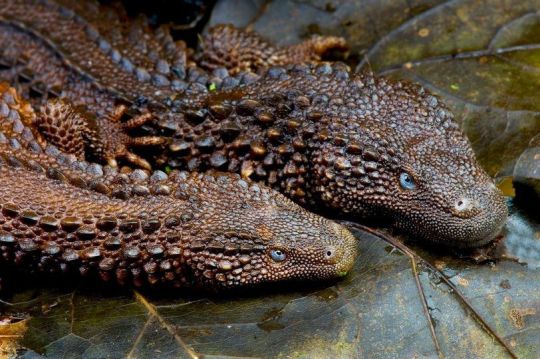
Earless Monitor Lizard (Lanthanotus borneensis), family Lanthanotidae, endemic to Borneo
ENDANGERED.
Semi-aquatic.
Closely related to the true monitor lizard in the family Varanidae.
The only member of its family.
They do have inner ears, and are capable of hearing, despite the lack of ear openings and tympana.
photographs by Chien C. Lee & Reptiles4all

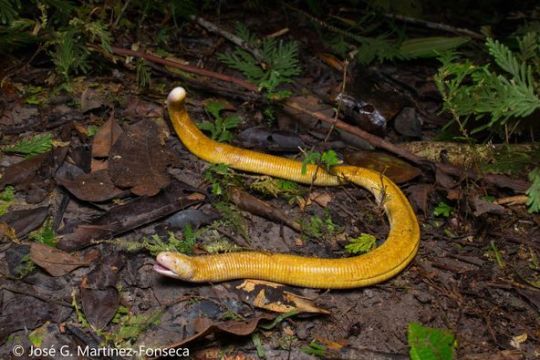
Red Worm Lizard aka White-bellied Worm Lizard (Amphisbaena alba), family Amphisbaenidae, foun din much of South America
photographs by Diogo B. Provete & Jose Gabriel Wildlife

Secret Toadhead Agama (Phrynocephalus mystaceus), defensive display, family Agamidae, found in found in Iran, North Afghanistan, Eastern Caucasus, Kazakhstan, Uzbekistan
photograph by Milan Zygmunt Photographer

Mossy Leaf-tailed Gecko (Uroplatus sikorae), family Gekkonidae, Madagascar
photograph by Inglourious Reptiles
2K notes
·
View notes
Text
November 22nd, 2023
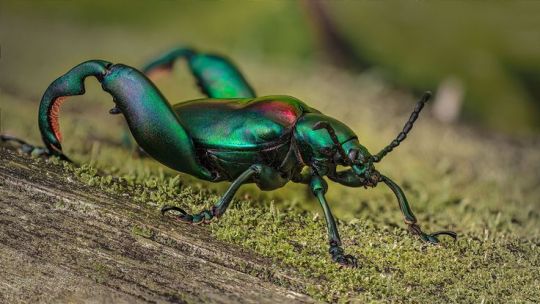
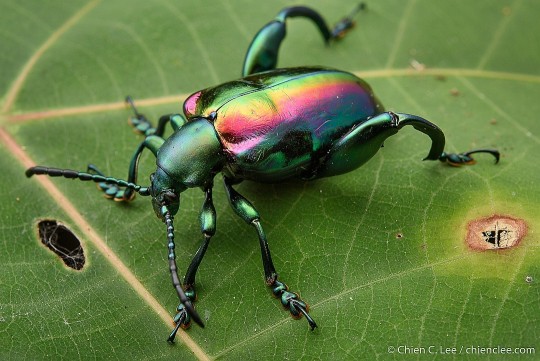
Frog Beetle (Sagra buqueti)
Distribution: Found in southeast Asia, in countries such as Thailand, Vietnam, Indonesia and Malaysia.
Habitat: Tropical jungle habitats, often found on stems or foliage.
Diet: Adults are generalist herbivores, feeding on the leaves, fruit and shoots of many plants. Larvae feed exclusively on certain species of kudzu.
Description: Unlike its namesake, the frog beetle doesn't use its powerful hind legs for jumping! Instead, it uses them to grip stems and foliage as it feeds, keeping itself still; the legs are covered in a multitude of tiny hairs which gives it a better grip. Male frog beetles have much larger legs than the females, which implies this trait is the result of sexual selection. Male frog beetles have never been observed fighting, but in similar species, legs are used to threaten other males, then to attack competitors by attempting to grab their abdomen.
Frog beetle cocoons are a fairly common sight in the tropical forests of southeast Asia. Despite this, very little is otherwise known about this species.
(Images by Eugenijus Kavaliauskas (male) and Chien C. Lee (female))
8 notes
·
View notes
Text

Waigeou Spotted Cuscus (Spilocuscus papuensis), family Phalangeridae, endemic to the island of Waigeo in Indonesia
photograph by Chien C. Lee
259 notes
·
View notes
Text
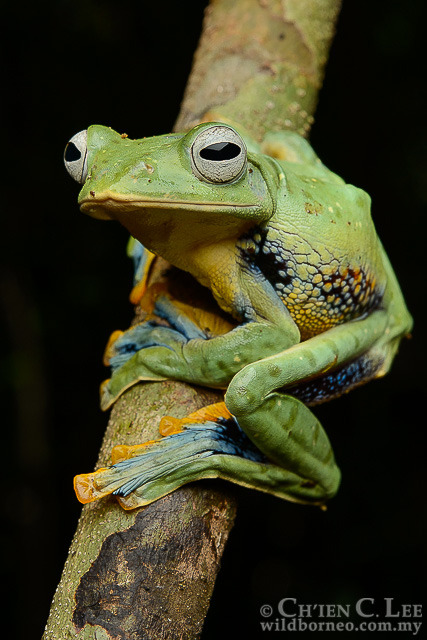
The Bornean Gliding Frog - by Chien C. Lee
Bornean Gliding Frog (Rhacophorus Borneensis), Female. Sarawak, Malaysia (Borneo).
2 notes
·
View notes